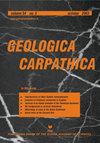浊积岩沉积学、生物地层学与古生态学——以渐新统祖别列克组为例。(喀尔巴阡山脉中西部利普托夫盆地)
IF 1.5
4区 地球科学
Q4 GEOSCIENCES, MULTIDISCIPLINARY
引用次数: 4
摘要
摘要LiptovskáOndrašová和Ráztoky附近的LiptovssáMara水库北岸暴露出厚浊积序列的露头。该剖面由卢比安时代的韵律性、主要为薄层至中层的浊积岩组成。它们的生物地层学是以钙质超微化石为基础的。这些沉积物的相组合代表了浊流扇系统中沉积凸角沉积物的不同组成部分,主要包括凸角边缘和凸角远边缘/凸角间相组合,局部包括凸角离轴相组合的中层沉积物。这一解释得到了统计分析的支持。深海浊积沉积包含微量化石组合,包括深层fodinichnia和domichnia,直至浅层象形文字。古水流测量表明,大部分沉积物质是从西南和西部输送过来的。本文章由计算机程序翻译,如有差异,请以英文原文为准。
Turbidite sedimentology, biostratigraphy and paleoecology: A case study from the Oligocene Zuberec Fm. (Liptov Basin, Central Western Carpathians)
Abstract Outcrops of a thick turbiditic succession are exposed on the northern bank of the Liptovská Mara reservoir near Liptovská Ondrašová and Ráztoky. The section consists of rhythmic, predominantly thin- to medium-bedded turbidites of the Rupelian age. Their biostratigraphy is based on the calcareous nannofossils. Facies associations of these deposits represent different components of depositional lobe deposits in the turbidity fan system, including mainly the lobe fringe and lobe distal fringe/inter-lobe facies associations and locally the medium bedded deposits of the lobe off-axis facies association. This interpretation is supported by statistical analysis. The deep-sea turbiditic deposits contain trace fossil associations, which include deep-tier fodinichnia and domichnia up to shallow-tier graphoglyptids. Paleocurrent measurements indicate that the majority of sedimentary material was transported from SW and W.
求助全文
通过发布文献求助,成功后即可免费获取论文全文。
去求助
来源期刊

Geologica Carpathica
地学-地球科学综合
CiteScore
2.40
自引率
23.10%
发文量
26
审稿时长
>12 weeks
期刊介绍:
GEOLOGICA CARPATHICA covers a wide spectrum of geological disciplines including geodynamics, tectonics and structural geology, volcanology, stratigraphy, geochronology and isotopic geology, karstology, geochemistry, mineralogy, petrology, lithology and sedimentology, paleogeography, paleoecology, paleobiology and paleontology, paleomagnetism, magnetostratigraphy and other branches of applied geophysics, economic and environmental geology, experimental and theoretical geoscientific studies. Geologica Carpathica , with its 60 year old tradition, presents high-quality research papers devoted to all aspects not only of the Alpine-Carpathian-Balkanian geoscience but also with adjacent regions originated from the Mediterranean Tethys and its continental foreland. Geologica Carpathica is an Official Journal of the Carpathian-Balkan Geological Association.
 求助内容:
求助内容: 应助结果提醒方式:
应助结果提醒方式:


